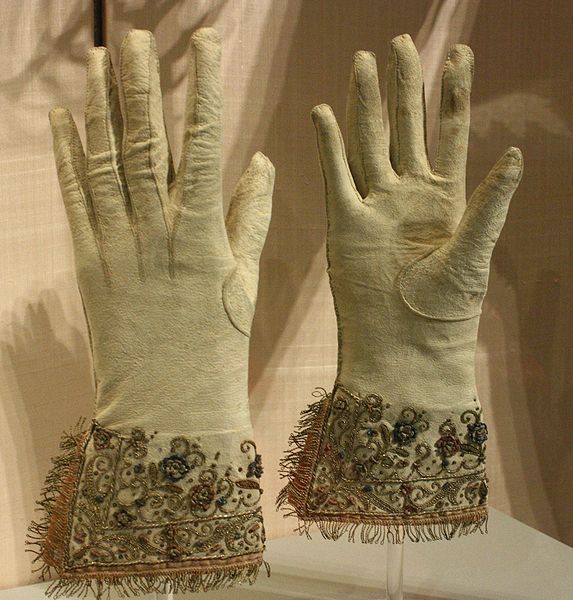How Catherine de Medici Made Gloves Laced with Poison Fashionable

Catherine de’ Medici, c. 1560. (Photo: Public Domain/WikiCommons)
Throughout history, Catherine de’ Medici has been considered something of a sorceress, a 16th-century French queen and banking heiress adroitly trained in the mixing of potions and capable of murder without a hint of remorse. One legend that has helped this reputation to endure is the story of Jeanne d’Albret, the Queen of Navarre.
France in the 1500s was a place of constant civil war between Catholics and Protestants. Jeanne d’Albret fiercely defended the Protestant cause in France and declared it the official religion of her kingdom, much to the displeasure of Catherine, a strict Catholic who was married to King Henry II of France. In an effort to unite the country, a marriage was arranged between d’Albret’s son, Henry, and Catherine’s daughter, the Princess Marguerite. What happened next has long baffled historians.
Correspondence from mother to son in the months leading up to the wedding is wrought with suspicion and hesitation about the arrangement, not to mention frustration at Queen Catherine’s cruel and often duplicitous ways. On March 8, 1572, d’Albret wrote:
I have spoken to the Queen three or four times. She only mocks me, and reports the contrary of what I have said to her, in order that my friends will blame me. I do not know how to deceive as she does. When I say, “Madame, they say that you have made such and such a proposal”, and it is the very thing she has said, she denies it, and laughs in my face…Others only command me to make you come, but I tell you the contrary.

Jeanne d’Albret, late 1500s. (Photo: Public Domain/WikiCommons)
Two months before the strategic wedding, Jeanne d’Albret died suddenly, along with all her resistance to keep the marriage from going forward. Many of the Protestants whose religion she championed during her lifetime believed the death to be murder and pointed to Catherine as the prime suspect. The choice of weapon? A pair of poisoned leather gloves.
When Catherine de’ Medici came to France by way of marriage, she brought with her several trends from her native Florence, including cooking utensils and techniques, Italian architecture, and beauty rituals. Italy in the 16th century was a fragrant place where perfume was used to scent skin as well as all articles of clothing. Catherine arrived in France with her personal perfumer, René le Florentin, and a vast collection of custom perfumes.
She promptly introduced perfumed gloves–or sweet gloves–to the French court, where men and women wore them as the ultimate emblem of prestige. Leather was the most popular choice for sweet gloves, but scenting a leather glove was no easy feat. To start with, the leather tanning process at the time used animal excrement, which gave the finished product a smooth finish but a repulsively rancid odor. This was why leather glove makers had turned to perfume to mask the less than luxurious smell in the first place.

A pair of embroidered leather gloves from from c.1615. (Photo: Valerie McGlinchey/WikiCommons CC BY-SA 2.0 UK)
Perfumers in the 16th century had to use many different natural ingredients for this to be successful, though. Sweet gloves were most commonly scented with herbs, spices, woods, and flowers such as jasmine, violet, iris, and orange blossom. It was a time consuming process: First, the ingredients were mixed with animal fat or oil, then boiled, and later separated. Gloves were then dipped into the fragrant liquid and left outside to dry. Depending on the material used and the power of odor desired, the process was repeated several times.
But although her sweet gloves became popular in court and throughout France, Queen Catherine was never truly accepted by the French people she ruled over, who viewed her as a manipulative foreigner with a passion for the Dark Arts. The French had long considered Italians masters of poison and witchcraft, and Catherine’s interest in and support for science–especially astronomy and astrology–was accepted as proof of her occultism.
She was also known for the unusual methods she experimented with to become pregnant, like ingesting the urine of pregnant animals. Of all of the challenges that Catherine faced during her lifetime, perhaps the most difficult was the accusation of her infertility. It took ten years for the King and Queen to conceive a child and all blame was placed upon the Queen. The public viewed all her attempts to influence the process as immoral.

A scene from a ball in Rouen, for Catherine and her husband Henry II. (Photo: Public Domain/WikiCommons)
The French already distrusted Queen Catherine, and the death, at 43, of her known enemy Jeanne d’Albret only added fuel to the fire. Protestants, in particular, were quick to accuse Catherine of the death of their prominent champion; one rumor that began to circulate was that Queen Catherine had murdered d’Albret with a pair of poisoned gloves.
Poison was a common killer in France at this time, and the rise of “The French School of Poisoners” is said to have inspired as many as 30,000 poisoners by 1572. Catherine’s image as a sorceress as well as her access to skilled specialists in the fields of science prompted many of her adversaries to allege she was involved in Jeanne d’Albret’s sudden death. After three religious civil wars in a period of ten years and constant assassination attempts on leaders of both religions, the death of a Protestant queen was assumed to be unnatural.
After all, the outspoken Queen of Navarre had been viewed by Catholics as a threat in need of silencing for some time. Furthermore, gloves were a common gift of the royal court, valued not only for their precious materials, but also for their symbolism. Gifted gloves, especially coming from a queen, conveyed a sentiment of loyalty and affection. Such was the intention of the Queen of Portugal, who in 1521 awarded the winning jousters of her court with a pair of perfumed gloves. Sweet gloves, of course, were indelibly linked with Catherine.

Henry of Navarre, son of Jeanne d’Albret, and Margaret of Valois, Catherine’s daughter. (Photo: Public Domain/WikiCommons)
Even though the discord between the two women was well known throughout France, many Protestants assumed that Queen Catherine would surely have sent a pair of sweet gloves to the mother of her son’s betrothed. It would have been rude not to. But was the royal gift laced with poison as well as scent?
The answer to this question came far too late to save Catherine de’ Medici’s reputation. The theory of Jeanne d’Albert’s death by poisoned gloves has since been discredited by modern historians, who consider it much more likely that d’Albert succumbed to tuberculosis. But the intrigue of the myth continues to prosper. It seems that we are more willing to believe a rumor about gloves infused with poison than we are to accept the mundane reality of a common malady.
What is certain is the Catherine brought to fashion the use of perfumed gloves in France. The artistry and symbolism of fragranced gloves is as exceptional as poisoned gloves, and would have certainly been a much lovelier gift to receive. In fact, the trend of the perfumed glove continues to this day, with brands like Guerlain and Maître Parfumeur et Gantier producing limited edition leather gloves saturated with fine fragrances. Perhaps this is all thanks to Queen Catherine de’ Medici.









Follow us on Twitter to get the latest on the world's hidden wonders.
Like us on Facebook to get the latest on the world's hidden wonders.
Follow us on Twitter Like us on Facebook